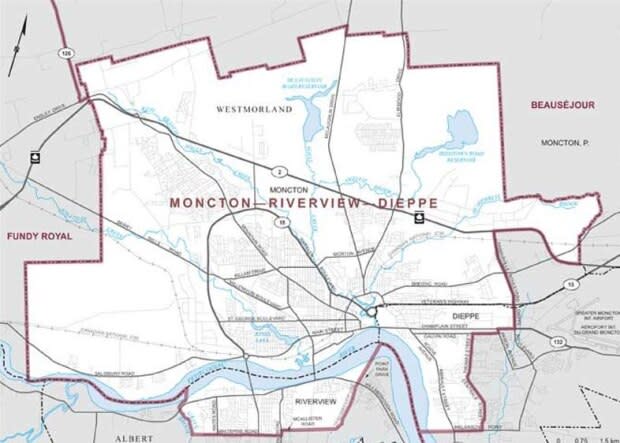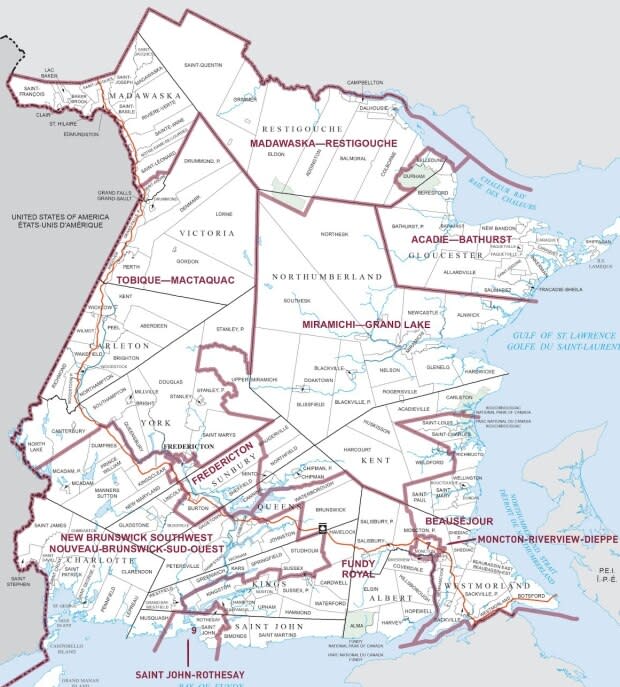Is your neighbour in a different federal riding? This is why
At an intersection along Whitepine Road in Riverview, drivers are besieged by election campaign signs, far more than your average high-traffic corner.
That's because the road marks the border between two federal ridings — Moncton-Rivervew-Dieppe to the north, Fundy Royal to the south. The boundary cuts Riverview almost in two, and Mayor Ann Seamans says it can be confusing for residents come election time.
Multiple residents on Brewster Street, one street south of Whitepine, told CBC News they should be included in the riding with neighbouring Moncton. They say their interests are not as closely aligned with Fundy Royal communities like Sussex and Quispamsis.
Seamans made a similar point in 2012 when officials readjusted the boundaries and opted to maintain the border through Riverview. Seven years later, the two-term mayor said she was speaking up for her residents, but she doesn't think the split has negatively affected the municipality.
It's better to have two MPs in your corner than one, she said.
It's not the only boundary in New Brunswick's 10 federal electoral districts that may raise an eyebrow.

Dieppe has a chunk of the city belonging to Beauséjour. Rothesay and Quispamsis, two communities that share several municipal services, are in different federal ridings. Rural villages south of Grand Lake, like Gagetown and Cambridge-Narrows, are tied to the Fundy Isles riding.
There are many communities along every boundary that would seem to be a more appropriate fit in the adjacent riding, but the line has to be drawn somewhere. And it's not an easy task for those charged with the duty.
Elections Canada describes the independent commissions that redraw the lines as "high-wire balancing acts" — a fair comparison, according to Patrick Malcolmson.
The retired political science professor was appointed to the three-member commission that readjusted the boundaries in 2012. He described the process and what it was like to walk that high wire.
How are federal ridings reshaped?
The Constitution requires that federal electoral districts be reviewed after each decennial census.
Redistribution, as it's called, is led by independent commissions established in each province.
A commission is permitted to tweak boundaries but not the number of ridings. For New Brunswick, that means keeping it at 10. The commission makes its recommendations, accepts feedback during public hearings and delivers a report to the chief electoral officer.

House members can object to the recommendations in the report. The commission must consider any objection but is not compelled to make any changes. A final report is submitted to the Speaker of the House. Once the speaker tables it, the commission's decisions are final.
Reflecting on the framework, Malcolmson said the Canadian system is probably "one of the best systems, at least at the federal level, that exists." He said typically people with legal or academic backgrounds are appointed to the non-partisan commissions.
"You find that, you know, basically the commissions are made up of people who have a lot of expertise and have no political axe to grind," he said.
They seek to improve representation, he said, not to manipulate constituency boundaries for political purposes, the gerrymandering often seen in the United States.
What criteria are used to adjust boundaries?
Each commission is given an "electoral quota," the number of residents permitted in a single district. It's essentially the province's population divided by number of ridings.
Commissions must draw the boundaries to be "as close as reasonably possible" to the electoral quota. In New Brunswick, the number during the most recent redistribution in 2012 was 75,117.
But they have some wiggle room.
It's a bit like Rubik's Cube, you know, because if you do that you have to change the boundaries somewhere else. - Patrick Malcolmson
The riding population has to remain within a 25 per cent margin on either side of the quota.
That's almost a 40,000-person window to work with in New Brunswick.
But it's still a tricky task, given the continuing migration to urban centres and depopulation of rural New Brunswick. Because of the population shift, the 2012 commission faced a crucial fork in the road early on in its work.
One option was adding surrounding population to urban centres and making more urban ridings — two each for the Moncton, Saint John and Fredericton areas — reducing the number of mixed or rural districts to four. The other option was to take a bit from urban centres and add to the other districts.
Commissioners opted for the latter.
"It's nice to sort of say, 'Well, we should have two ridings for each [region] of the major cities,'" Malcolmson said, "but I think you'd have quite a groundswell of discontent from people who live outside the cities that now they're really not going to have a voice. And I think they already feel that they don't have a voice."
The Riverview/Fundy Royal issue began with a proposal to put all of Dieppe in the Beauséjour riding, leaving Moncton and Riverview as one. But residents of Dieppe objected. So to meet the population quota, parts of Riverview and Moncton were moved into adjacent ridings instead.
"I think we were sort of caught on two sides and, ultimately, made what we thought was the best decision," he said.
"It's a bit like Rubik's Cube, you know, because if you do that you have to change the boundaries somewhere else."
What else is taken into account?
Commissions also need to consider manageable geographic sizes for the districts and communities of interest.
A community of interest is a key idea in shaping the boundaries in order to enhance representation. The notion is open to interpretation, but Elections Canada calls it a "counterweight" to the cold, hard math of divvying up things by population.

"Strict population equality may well mean the splintering of otherwise natural communities," that share municipal boundaries, economic interests as well as social, racial, religious or linguistic characteristics.
On multiple instances, francophone groups in the province challenged boundary adjustments out of concern it would diminish francophone representation.
The Federal Court made history in 2004 by halting a boundary change that sought to move some Acadie-Bathurst residents into the predominantly anglophone Miramichi riding.
The New Brunswick commission tasked with the 2002 redistribution also proposed having every First Nation vote in the Miramichi riding, even though only three were in the geographic area. The idea was to boost Indigenous representation, but the plan was met with heavy opposition and eventually scrapped.
During the 2012 redistribution, the commission decided to roll Belledune into Acadie-Bathurst. The village, which is located between Campbellton and Bathurst, was previously part of the Miramichi riding "for no apparent reason," the commission wrote.
What's next?
The next decennial census is scheduled for 2021, meaning another boundary readjustment will soon be upon us.
"I would imagine the trend towards, you know, greater urbanization in the province has continued and there's a sort of process of rural depopulation happening," Malcolmson said.
"At some point, whether it's this time or next time, you're going to reach the tipping point and there's going to have to be a more substantial redistribution than there was.
"The commission will have to look pretty, pretty hard at redrawing those boundaries, and that will not be a walk in the park."


